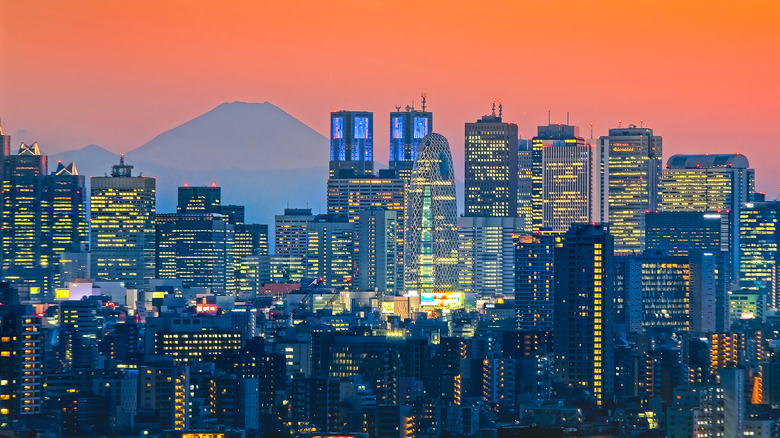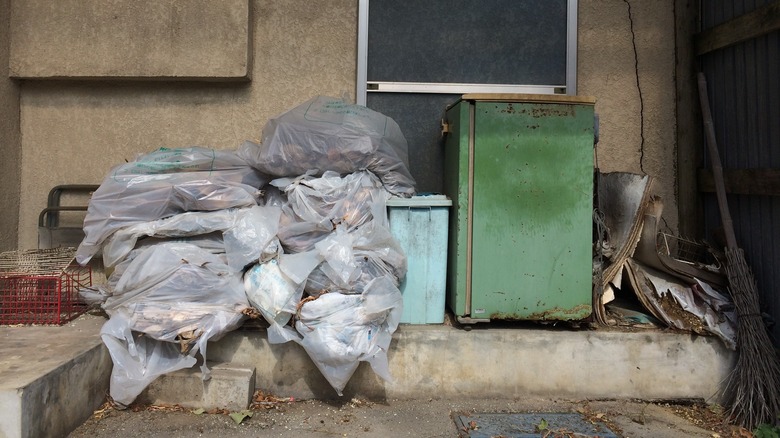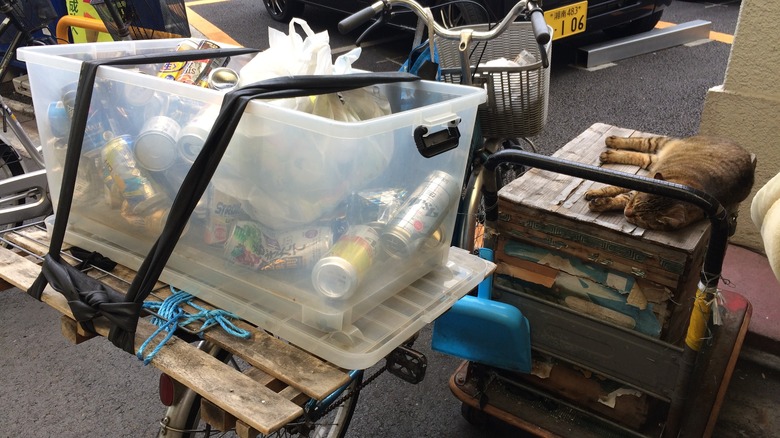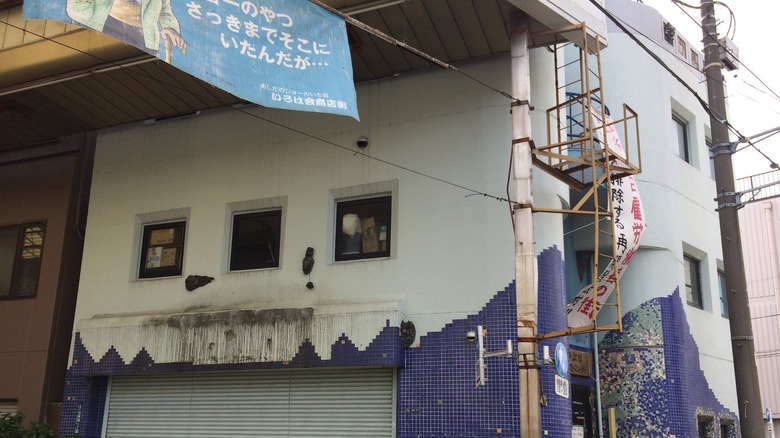The Truth About Sanya, Tokyo's Lost District
Walking around the streets of Tokyo, especially busier nightlife areas like Shinjuku, you might occasionally notice something that looks a plastic blue tarp discarded under a bridge, draped over a railing, or covering a pile of trash bags. These tarps, which are common come springtime for people to use for picnics under cherry blossom trees, serve as a signal to locals, along with nearby beds of layered cardboard: Here there be homeless people. But unlike lots of other major cities like New York or Los Angeles, you won't "see" homeless people too often in Tokyo. If you do, they'll never ask for anything, or even make eye contact. And if you do see them, you'll notice that no other person glances at them, either.
At recent count, per Live Japan, about 14 million people live within Tokyo proper, with its 23 central districts, or "wards." The entire greater Tokyo area, which stretches out in the west to Mt. Takao, down into Kanagawa and its main city, Yokohama, up towards Saitama and Chiba in the north, contains a staggering 38 million people. That's about 30% of the population of the entire country.
And yet, per the Japan Times, in 2021 the Japanese Ministry of Health, Labor, and Welfare reported only 3,824 homeless people across the entire country. That's only 0.00003% of the population. Is this actually possible? Is that why there are so few homeless people on the streets? Unfortunately, no. The answer is far more heart-breaking.
Refuge for the voluntarily vanished
In Japan, pressures to conform are extreme. So extreme, in fact, that when coupled with the absolute terror of being an embarrassment to society, people sometimes do the unthinkable: They voluntarily vanish. As in, erased from existence. Not governmental records, of course, but their lives. There are actual companies — "night movers" — that people can hire to more or less scuttle them away from society, permanently. These vanished people, johatsu, amount to roughly 100,000 per year since the mid-1990s, per the New York Post. In a society where pressure is so vast — endless unpaid overtime, extreme educational expectations, the eyes of strangers judging each action in public — opting out is sometimes a simpler, even happier choice. "Police will not intervene unless there's another reason," sociologist Hiroki Nakamori told the BBC. "All the family can do is pay a lot for a private detective. Or just wait. That's all."
These vanished individuals are not accounted for in censuses and governmental tallies, like the aforementioned report on homeless numbers from the Japanese Ministry of Health, Labor, and Welfare on the Japan Times website. They're a hush-hush, embarrassing secret. Besides which, such reports can never find every single homeless person across an entire nation.
In a metropolis like Tokyo, many of these individuals end up in the former district of Sanya. Sanya was once part of surrounding areas, but was redistricted away to obliterate its damning numbers. Its people, though, remain.
A ghost town of poverty, decay, and occasional hope
Sanya is like a ghost town that happens to be inhabited by scattered groups of people. Many buildings are collapsing in on themselves, sodden with decades of untended decay, roofs of corrugated metal eaten by rust. Mailboxes are stuffed full of untouched junk mail because owners are long gone. People potter around on the streets, almost exclusively older men, congregating around curbs and drinking. Commerce does exist in Sanya, but it's threadbare, and held together by scattered diners and run-down mom-and-pop shops. Sanya's entire crosshatch of streets is a shocking contrast to much of the rest of Tokyo, and will blow the mind of anyone who envisions Tokyo to be only its sleekest, most neon parts.
Halfway houses and similar facilities are a common sight in Sanya, such as House of Hope ("Kibo no Ie"), opened in 2002 by founder Masaki Yamamoto, now run by him and his wife Mie. As Yamamoto told the Japan Times, he takes care of not only those "facing imminent death, but also to those who have fallen through society's cracks." He gets referrals from hospitals and social workers who have nowhere else to place people. As such, those he cares for have everything from HIV to cancer, Parkinson's to schizophrenia. It's important to note that mental health care is lagging in Japan — exasperatingly so — due to the same social stigmas facing those who decide to disappear.
The builders of Tokyo, discarded
The overwhelming majority of those who live homeless or semi-homeless in Sanya are day laborers. This alone is yet another stigma, as the ultimate Japanese societal ideal remains, to this day, to lodge oneself within a white-collar, corporate entity and remain there until retirement (though that ideal is shifting among younger generations). One such laborer who goes by "Katchan" spoke to The Guardian in 2019 while hanging out in Tamahime park. His attitude was brighter than his surroundings and station would indicate. "I've come here to drink, chat and enjoy the weather — sunlight is free after all," he said. "I only get very occasional work, but I've stayed here because this is where my friends are." At the time, Katchan had lived there 16 years.
Katchan's final statement highlights the current truth of Sanya: It is its own community. At this point, it's even a generational community, because younger people have joined the ranks of their elders.
Many of those who wound up in Sanya for economic reasons, rather than self-disappearing, were responsible for the reconstruction of Tokyo in the years leading up to the country's landmark 1964 Olympics, which announced to the world that Japan was ready to rejoin the global community. Sanya began as a dumping ground for day laborers who rebuilt Tokyo and were no longer needed. In fact, as far back as 1966, the government struck "Sanya" from the records, and redistricted it into its current halves: Kiyokawa and Zutsumi.



